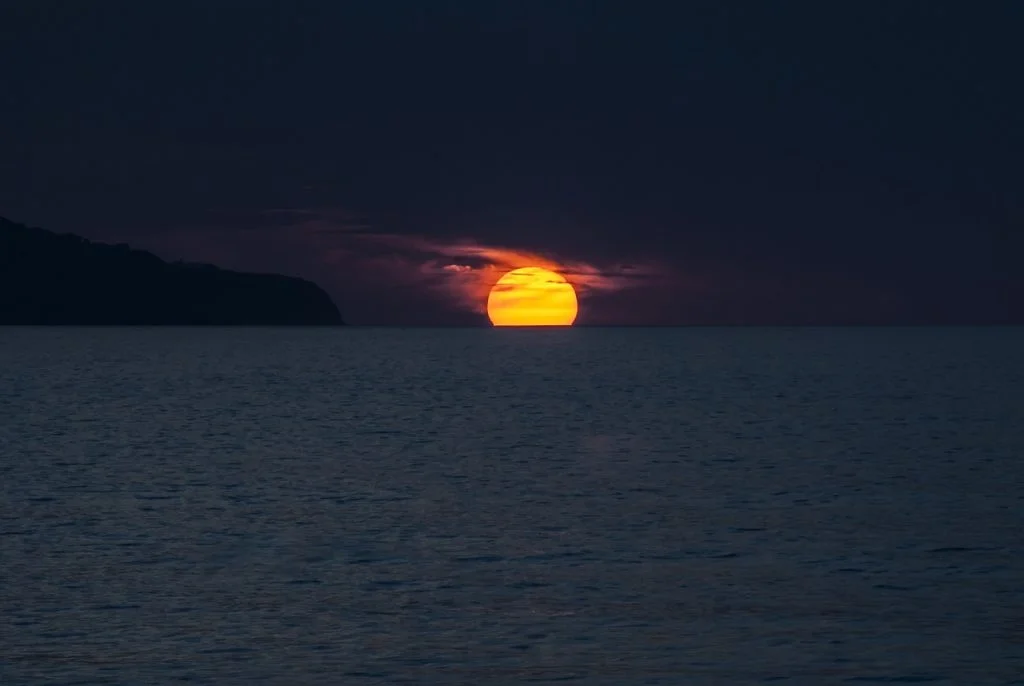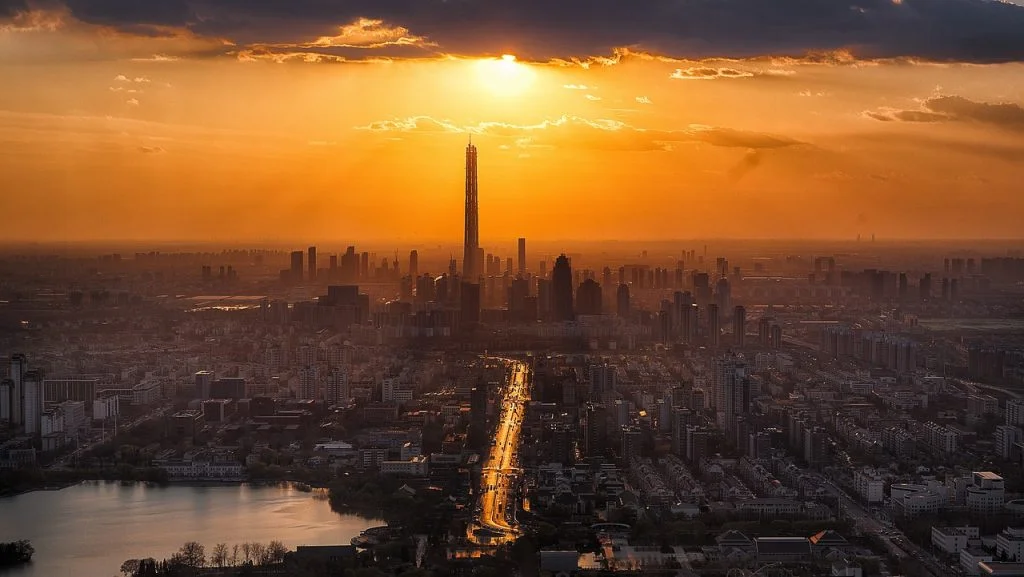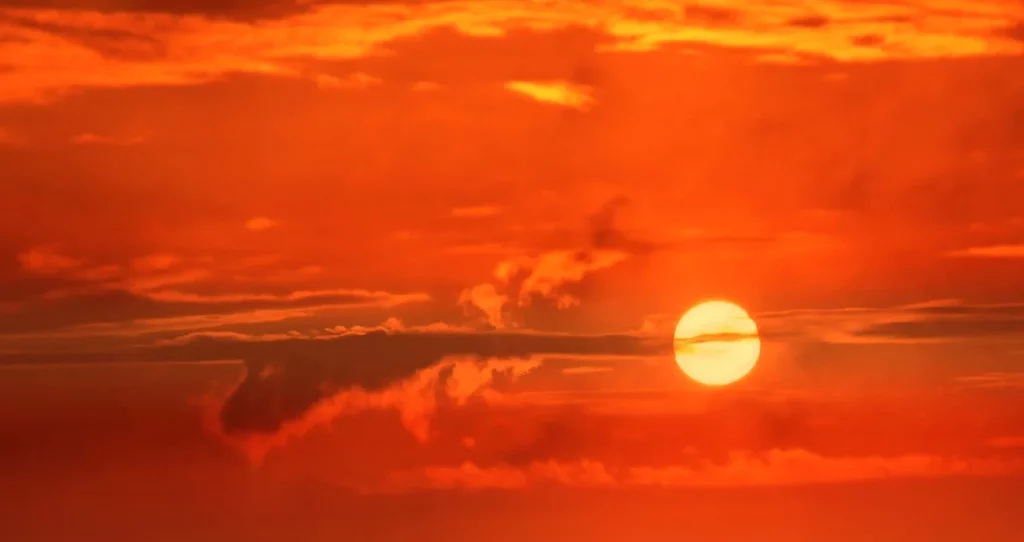Welcome to the world of our star, the Sun! Did you know that it’s been shining down on us for about 4.6 billion years? That’s a lot of sunburns, right? The sun, a ball of fiery passion, is like the universe’s own natural spotlight, keeping us warm and occasionally making us squint really hard.
It’s so important that entire civilizations have thrown festivals in its honor – and you thought your birthday parties were big! But have you ever wondered just how many Earths could fit inside this gigantic star? Let’s embark on a journey of epic facts and solar surprises!
Keep your face always toward the sunshine – and shadows will fall behind you.
Walt Whitman
Sun Facts
Get ready to dive into the dazzling world of fun facts about the sun! And remember, there’s a quiz waiting for you at the bottom of the page, so keep your eyes peeled as you explore these scintillating sun secrets.
- The sun is a G-type main-sequence star (G2V), commonly referred to as a yellow dwarf.
- It’s approximately 4.6 billion years old and formed from the gravitational collapse of a region within a large molecular cloud.
- The sun’s diameter is about 1.39 million kilometers (865,000 miles), which is 109 times greater than that of Earth.
- About 99.86% of the solar system’s mass is contained within the sun, with most of this being hydrogen and helium.
- The sun’s core reaches temperatures of about 15 million degrees Celsius (27 million degrees Fahrenheit).
- Every second, the sun converts approximately 4 million tons of matter into energy through nuclear fusion.
- The sun’s surface, or photosphere, has a temperature of around 5,500 degrees Celsius (9,932 degrees Fahrenheit).
- The sun’s atmosphere is composed of the photosphere, chromosphere, and the corona.
- Solar flares and coronal mass ejections are caused by magnetic activity on the sun.
- The sun’s magnetic field flips approximately every 11 years, a period known as the solar cycle.
- Earth’s distance from the Sun is about 150 million kilometers (93 million miles), a measure known as an Astronomical Unit (AU).
- Sunlight takes about 8 minutes and 20 seconds to reach Earth.
- The sun moves through the Milky Way in a path known as the Solar Apex, located in the constellation Hercules.

- The sun’s energy output, known as solar luminosity, is approximately 3.828 x 10^26 watts.
- Helioseismology is the study of the sun’s interior by observing its surface oscillations.
- The sun’s chromosphere is visible during solar eclipses, revealing a reddish glow.
- The corona, the outer layer of the sun’s atmosphere, is much hotter than its surface.
- The sun’s influence, known as the heliosphere, extends far beyond the last planet in our solar system.
- Sunspots are temporary phenomena on the Sun’s photosphere that appear as spots darker than the surrounding areas.
- The solar wind is a stream of charged particles released from the upper atmosphere of the Sun.
- Earth’s climate and weather are significantly influenced by the solar irradiance.
- The sun’s magnetic field extends beyond Pluto, in what is known as the heliospheric current sheet.
- Ancient civilizations often worshiped the sun as a deity, recognizing its importance for life on Earth.
- The Ulysses spacecraft was specifically designed to study the sun’s poles and solar wind.
- Solar energy is a major source of renewable energy, harnessing the Sun’s power.
- The sun’s mass consists of about 75% hydrogen and 24% helium by mass.
- The Granulation seen on the sun’s surface is caused by convective motions of the plasma.
- Parhelion (sun dogs) are an atmospheric phenomenon that creates bright spots around the Sun.

- The Solar Maximum Mission satellite was used to observe solar flares and coronal loops.
- Coronal holes are areas of the corona where the sun’s magnetic field reaches out into space rather than looping back.
- Solar prominences are large, bright features extending outward from the sun’s surface.
- The sun’s composition changes over time as it converts hydrogen to helium in its core.
- Auroras on Earth are caused by the interaction of the solar wind with Earth’s magnetosphere.
- The Goldilocks Zone refers to the habitable zone around a star where temperatures could allow for liquid water.
- The sun’s energy plays a critical role in the process of photosynthesis in plants.
- Greenhouse gases in Earth’s atmosphere trap heat from the sun, contributing to global warming.
- Space weather forecasts are important for understanding the sun’s impact on Earth.
- The SOHO satellite has provided valuable data on the Sun since its launch in 1995.

- The sun’s core is under tremendous pressure, equivalent to a force of 340 billion times Earth’s atmospheric pressure at sea level.
- Mercury is the closest planet to the sun, but it’s not the hottest (that title goes to Venus).
- Solar sails are a proposed form of spacecraft propulsion using the radiation pressure from the sun.
- The Parker Solar Probe is a mission to study the outer corona of the Sun.
- During a solar minimum, the sun has fewer sunspots and less solar activity.
- Total Solar Irradiance (TSI) is a measure of the solar power over all wavelengths per unit area.
- The sunrise and sunset colors are due to the scattering of light caused by Earth’s atmosphere.
- Limbs of the Sun refer to the outer edge of the solar disk as seen from Earth.
- The sun’s equatorial rotation period is about 24 days, but it’s longer near the poles.
- Stellar nucleosynthesis in the sun produces heavier elements like carbon and oxygen.
- The Yohkoh satellite helped in understanding solar flares and coronal structures.
- Sunquakes are seismic activities on the sun caused by solar flares.
Sun Myths

Now that we’ve illuminated your mind with interesting facts about the sun, let’s shine a light on the myths and facts that often orbit around our star.
- The Sun is a Giant Ball of Fire
The sun is not actually on fire. It’s a massive sphere of plasma, primarily made of hydrogen and helium, undergoing nuclear fusion. This process converts hydrogen into helium in its core, releasing tremendous amounts of energy as light and heat. - The Sun is Yellow
It actually emits light that is white. The Earth’s atmosphere scatters blue light, making the sky appear blue and the sun yellow. From space, the sun looks more white than yellow. - Solar Flares Can Reach Earth
While solar flares are powerful bursts of radiation, they cannot physically reach Earth’s surface. However, when intense enough, they can disturb the atmosphere in the layer where GPS and communications signals travel. - The Sun is Unchanging and Constant
The sun is quite dynamic and changes over time. It has an 11-year solar cycle which includes periods of increased and decreased solar activity, affecting things like sunspots and solar flares. - Sunscreen is Only Needed on Sunny Days
UV rays from the sun can penetrate clouds, so it’s important to wear sunscreen even on cloudy days to protect your skin from harmful ultraviolet radiation.
No products found.
Sun Quotes

It’s time to share my collection of five favorite quotes about the sun. I am more than happy to hear yours in the comments section.
The sun does not shine for a few trees and flowers, but for the wide world’s joy.
Henry Ward Beecher
Henry Ward Beecher, a prominent American Congregationalist clergyman, social reformer, and speaker, highlights the sun’s universal benefit, providing light and warmth to the entire world, not just a select few.
To love and be loved is to feel the sun from both sides.
David Viscott
In this quote, David Viscott, an American psychiatrist, author, and media personality, draws an analogy between the warmth and brightness of the sun and the experience of mutual love.
Even the darkest night will end and the sun will rise.
Victor Hugo
Famous French poet and novelist Victor Hugo offers a message of hope with this quote, suggesting that no matter how difficult a situation may seem, it will eventually give way to better times.
Ô, Sunlight! The most precious gold to be found on Earth.
Roman Payne
Roman Payne, an American novelist, and poet, compares sunlight to the most valuable gold, emphasizing its unparalleled worth and beauty.
Turn your face to the sun and the shadows fall behind you.
Maori proverb
This Maori proverb conveys a similar message to Whitman’s quote, encouraging a focus on the positive (the sun) so that the negative (shadows) is left behind.
Sun FAQ

As we transition from the inspiring world of sun quotes to the enlightening FAQs, remember to read each question carefully because the quiz is just after this section.
- Can sun poisoning make you sick?
Absolutely. Sun poisoning can definitely make you feel unwell. It’s a severe form of sunburn that not only damages your skin but can also cause symptoms like nausea, fever, chills, and dehydration. It’s really important to take sun exposure seriously and protect yourself with sunscreen, hats, and by seeking shade, especially during peak sun hours. - Where does the sun rise first in the world?
The first place to see the sunrise in the world is usually at the top of Mount Hikurangi in New Zealand. This spot is the first to greet the sun each day, given its location and elevation. However, this can change slightly throughout the year due to the Earth’s tilt and orbit. - Which sun rays cause cancer?
The sun emits ultraviolet (UV) rays that can be harmful to our skin. There are two main types of UV rays that reach the Earth’s surface – UVA and UVB. Both can cause skin cancer, but it’s mainly the UVB rays that are responsible for most skin cancers. They cause damage to the skin’s DNA, leading to mutations and eventually cancer if not protected against. - Why does the sun make you tired?
Spending time in the sun can be exhausting for a few reasons. Firstly, your body works hard to regulate its temperature in the heat, which can use up energy. Also, UV radiation can lead to dehydration, another energy drainer. Plus, being outdoors and active in the sunshine can naturally tire you out. - Is the sun a star or a planet?
It is definitely a star, and it’s our closest star at that! Unlike planets, which reflect light, stars like the sun produce their own light through nuclear fusion in their cores. This process converts hydrogen into helium, releasing a tremendous amount of energy in the form of light and heat, which is what we experience here on Earth.
No products found.
Sun Trivia

Get ready to shine in the Sun quiz! But beware, a score of zero might just land you a one-way ticket to Pluto – the coldest spot for the not-so-hot quiz takers!
Sun Merch
If you are a true sun fan, then you definitely need to check out our merchandise. You can find T-shirts, hoodies, mugs, and tote bags for your favorite designs. Feel free to check out all the other designs in our shop.
Conclusion
And that’s it! Our star, the Sun, isn’t just a giant, flaming ball of gas—it’s a star with flare, quite literally. It’s the reason our plants grow, our beaches are bustling, and our days are, well, day-like. It’s also why you sometimes find your car seat scorching hot—thanks, Sun!
As we conclude our solar trip, here’s a fun thought: if the sun were to take a vacation, where would it go to chill? Would it prefer the dark side of the moon or a nice, cool nebula? Beam up your thoughts and let me know!
7 Sources Used For This ArticleSun Facts – Space Facts
Sun – National Geographic Education
The Sun – Academic
Our Sun And Heliosphere – Solar Cell Central
55 Mesmerizing Facts About The Sun – Teaching Expertise
Our Solar System – National Geographic


